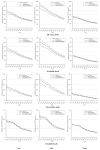Avoidable Mortality between Metropolitan and Non-Metropolitan Areas in Korea from 1995 to 2019: A Descriptive Study of Implications for the National Healthcare Policy
- PMID: 35329162
- PMCID: PMC8955663
- DOI: 10.3390/ijerph19063475
Avoidable Mortality between Metropolitan and Non-Metropolitan Areas in Korea from 1995 to 2019: A Descriptive Study of Implications for the National Healthcare Policy
Abstract
This study aims to investigate the trends of avoidable mortality and regional inequality from 1995 to 2019 and to provide evidence for policy effectiveness to address regional health disparities in Korea. Mortality and population data were obtained from the Statistics Korea database. Age-standardized all-cause, avoidable, preventable, and treatable mortality was calculated for each year by sex and region. Changes in mortality trends between metropolitan and non-metropolitan areas were compared with absolute and relative differences. Avoidable mortality decreased by 65.7% (350.5 to 120.2/100,000 persons) in Korea, 64.5% in metropolitan areas, and 65.8% in non-metropolitan areas. The reduction in avoidable mortality was greater in males than in females in both areas. The main causes of death that contribute to the reduction of avoidable mortality are cardiovascular diseases, cancer, and injuries. In preventable mortality, the decrease in non-metropolitan areas (-192.4/100,000 persons) was greater than that in metropolitan areas (-142.7/100,000 persons). However, in treatable mortality, there was no significant difference between the two areas. While inequalities in preventable mortality improved, inequalities in treatable mortality worsened, especially in females. Our findings suggest that regional health disparities can be resolved through a balanced regional development strategy with an ultimate goal of reducing health disparities.
Keywords: avoidable death; health inequality; preventable death; regional inequality; treatable death.
Conflict of interest statement
The authors declare no conflict of interest.
Figures


References
-
- OECD Health Statistics. [(accessed on 25 November 2021)]. Available online: https://stats.oecd.org/index.aspx?queryid=30115#.
-
- Choi M.H., Yoon T.H. Trends in amenable mortality to health care across the districts in Korea from 1993 to 2013. J. Crit. Soc. Welf. 2015;49:404–432.
-
- Choi M.H., Kim A.R., Yoon T.H. Health inequality between people with and without disability and impact factors: Focusing on avoidable death. JKADS. 2018;20:2105–2119.
-
- Cho K.H., Lee S.G., Nam C.M., Lee E.J., Jang S.Y., Lee S.H., Park E.C. Disparities in socioeconomic status and neighborhood characteristics affect all-cause mortality in patients with newly diagnosed hypertension in Korea: A nationwide cohort study, 2002–2013. Int. J. Equity Health. 2016;15:1–9. doi: 10.1186/s12939-015-0288-2. - DOI - PMC - PubMed
Publication types
MeSH terms
LinkOut - more resources
Full Text Sources
Medical

